You probably know Universal Nutrition's Animal Team from their legendary Animal Pak multivitamin pack, and you may know about their incredibly formulated Animal Primal pre-workout supplement.
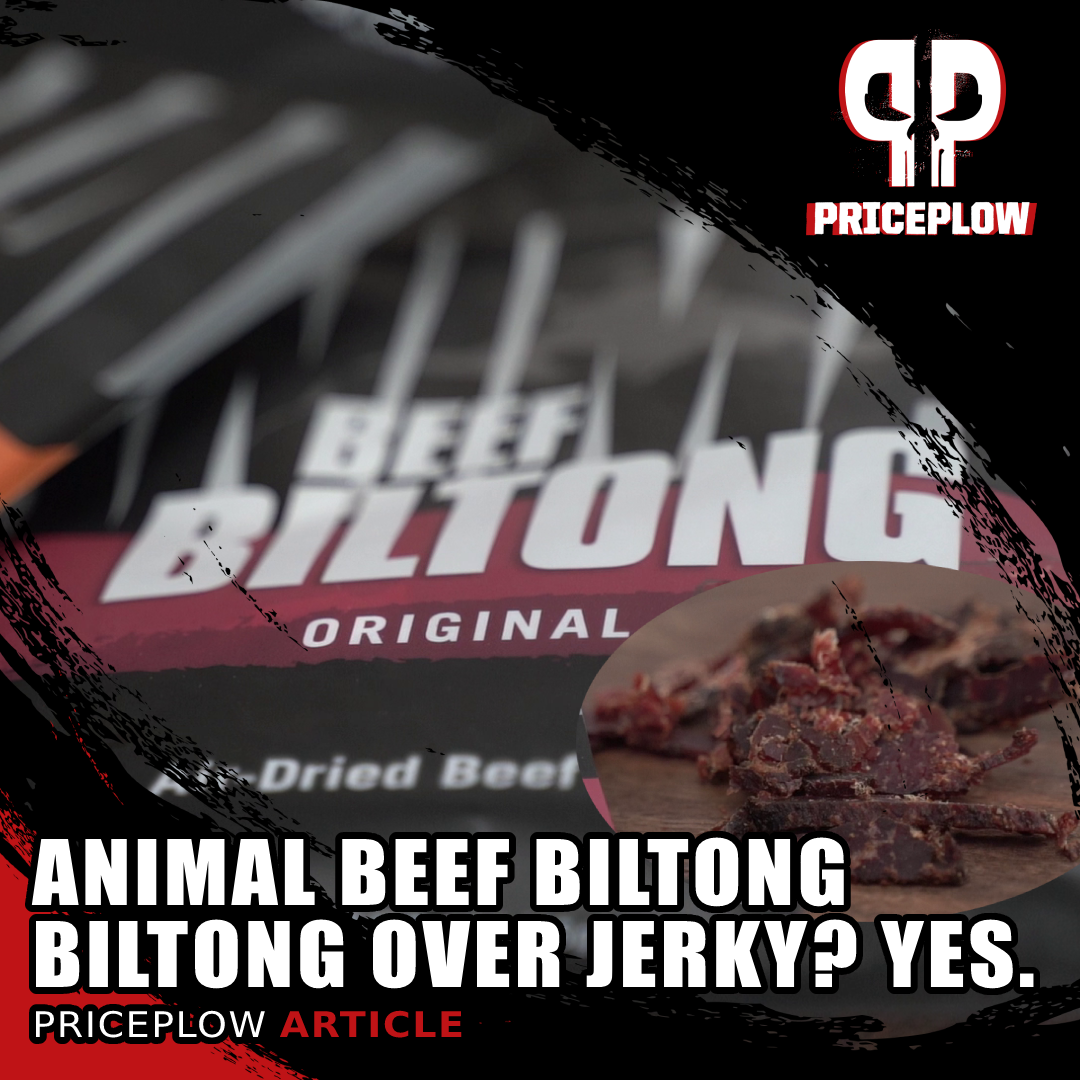
Introducing Animal Beef Biltong from Universal Nutrition! If you haven't researched biltong, now's your chance. This stuff is unreal.
The company has had numerous protein bars over the years, and even has an incredible desiccated liver tablet supplement known as Uni-Liver. But what they've released in 2022 is unlike anything else in the product line -- because it's beef biltong.
Animal Beef Biltong is here, and it’s spectacular
Universal Nutrition's Animal Beef Biltong is no traditional supplement - it's a high-protein snack - and it's no bag of beef jerky either.
Coming in three delicious flavors, we had to figure out why this stuff was so good. It turns out that beef biltong isn't the same as beef jerky.
In this article, there's no way to skirt around the subject - we go pretty hard in the paint. We explain the benefits of red meat, discuss biltong vs. jerky, and seriously analyze the sodium situation - a mineral we do not fear on this site. We also talk about biltong's secret weapon -- coriander!
Before diving in deep, let's check out the flavors and prices. This is one you simply won't want to miss, only question is what flavor to get:
Universal Animal Beef Biltong – Deals and Price Drop Alerts
Get Price Alerts
No spam, no scams.
Disclosure: PricePlow relies on pricing from stores with which we have a business relationship. We work hard to keep pricing current, but you may find a better offer.
Posts are sponsored in part by the retailers and/or brands listed on this page.
This area is reserved for Team PricePlow's upcoming Product Review video.
Subscribe to our channel and sign up for notifications so you catch it when it goes live!
The redder the better: Why red meat?
There are many reasons why you might want to eat more red meat. Maybe you're a bodybuilder or an athlete trying to maximize your muscle and know that the latest research shows a strong correlation between dietary protein intake and lean mass gains.[1]
Or maybe you're following the high-fat, low-carb way of eating – perhaps even a ketogenic diet – for the sake of your health and wellness. After all, restricting dietary carbohydrate intake has been a life-changing practice for millions of people, helping to normalize blood glucose and insulin levels,[2,3] improve markers of cardiovascular health,[4-6] and cause healthy weight loss.[7,8]
Maybe you're trying to optimize your hormones, and are aware that certain minerals in red meat— chiefly zinc— have a powerful effect on your body's ability to produce sex hormones, like testosterone.[9] Maybe you've also heard that low fat diets and high unsaturated fat intake can tank testosterone production[10] and you're trying to get in on some of that awesome stearic acid, the second most plentiful saturated fatty acid in beef.
Don’t be fooled: red meat contains the healthy fats
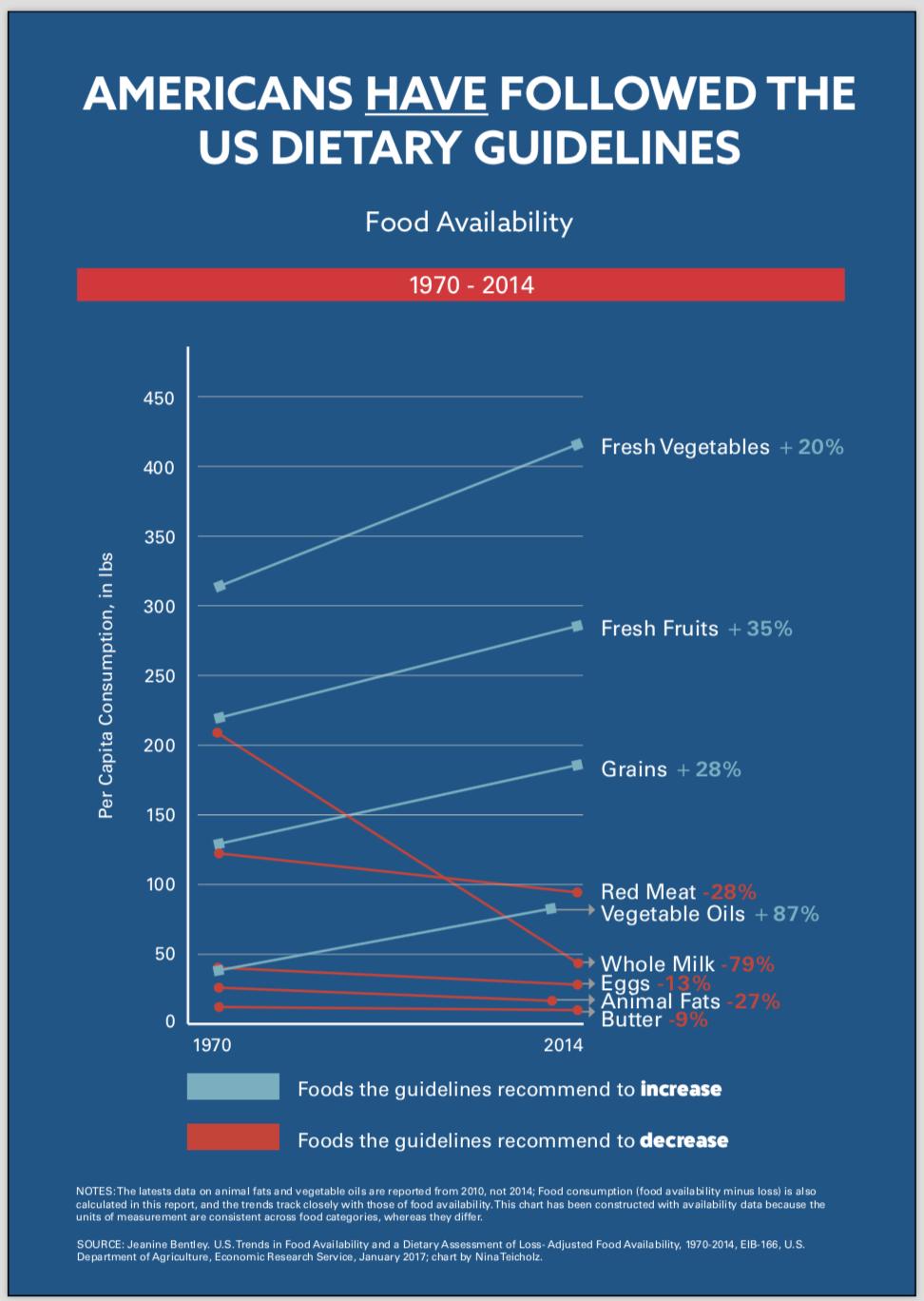
Americans did listen to the food guidelines.. and we got sicker and fatter than ever. Are we sure red meat, saturated fat, and cholesterol are really the issue?! It's time to bring back ancestral foods made the way we used to.
Especially since you, a savvy consumer, are hip to emerging scientific evidence that saturated fat intake itself does not increase the risk of cardiovascular disease,[11-15] and neither does dietary cholesterol.[16]
Stearic acid, in particular, has a variety of health benefits. Possibly the biggest is that it can cause mitochondrial fusion, a process that significantly improves overall mitochondrial function.[17]
This effect means that stearic acid, far from causing heart disease, may in fact be a boon for cardiovascular health.[17] According to one study in human subjects, 19 grams of daily stearic acid consumption significantly reduced volunteers risk of abnormal blood clots and arterial plaque formation.[18]
So there are lots of reasons to get more red meat in your diet – and this list, although impressive, is by no means exhaustive.
How can we make red meat a snack?
The problem, of course, is that meat is not readily available as a convenience food. Also, carrying non-preserved meat around with you all day isn't advisable, for obvious food-safety reasons.
Cured meats, like salami and prosciutto, are always an option, but these come with drawbacks of their own. For one thing, they're typically high in sodium nitrate and sodium nitrite, the consumption of which has been linked to potential health problems like diabetes and cancer.[19]
It's also difficult to find cured beef – the overwhelming majority of cured meats available in a typical grocery store are made from pork, which some people choose not to eat for religious or nutritional reasons.
The Solution: Animal Beef Biltong, from Universal Nutrition
In response, Team Animal at Universal Nutrition has introduced their own take on biltong to the U.S. market, with Animal Beef Biltong.
What is biltong?!
Biltong is a kind of cured beef. It was invented over 400 years ago by indigenous peoples of South Africa who salted meat and hung it on hooks to air dry as a preservative method. European settlers, upon their arrival to the continent, tweaked and perfected the curing recipe by introducing vinegar, coriander, and other spices.
The fusion of these cultural practices came to be known to Dutch settlers as biltong, from the Dutch bil meaning "meat" or "rump," and tong meaning "strip". So the name biltong is literally translated, aptly enough, as "strip of beef".[20]
Because of its long shelf life, impressive nutritional benefits, and high protein content, biltong has been used over the centuries as a convenient travel food for migrating settlers, as well as rations for seafarers and soldiers.[20]
We moderns can use Animal Beef Biltong as a convenient snack to support our nutritional and athletic goals. Simply throw a package into your bag, backpack, or jacket pocket when you leave the house, and you have a ready-to-eat meal to tide you over until you get home.
Biltong vs. Jerky
So why not just buy jerky?
First of all, many jerky products come with the same issues we raised earlier in the paragraph on cured meat: typically, low-cost jerky (the kind sold in convenience stores) is made with low-grade beef and lots of preservatives, including sodium nitrate and sodium nitrite.
If you prefer jerky, there are several premium brands that don't use any of that stuff.
But we like Animal Beef Biltong because, unlike jerky, it isn't cooked - it's simply cured in brine and dried, giving it a moist, chewy texture similar to salami and prosciutto.
Jerky, on the other hand, is typically smoked for several hours. As a result, the meat can be tough to chew and can take a long time to eat – something that, besides being slightly unpleasant, is particularly inconvenient when you need to eat in a hurry. And if you have issues with tooth or jaw pain, then jerky is a nonstarter. With biltong you sidestep these problems.
Sodium in Biltong: Is it even a concern?
Admittedly, biltong contains a lot of sodium – nearly 1,000 milligrams in a single 2-ounce bag. This is all going to depend on where your stance on sodium lies.
High sodium content may not be as big of a problem as you might think. Although we can't definitively say that a high sodium intake won't increase your risk of disease, it's clear from a sober-eyed review of the research literature that the evidence supporting sodium restriction for health purposes is conflicting— and quite weak.
Although physicians in America are trained to denounce your salt shaker as soon as you show the slightest sign of hypertension, several large, high-powered studies on the subject, performed by respected researchers and institutions, have failed to produce evidence that sodium is as bad as previously believed, demonstrating that current sodium guidelines are inaccurate.
To give one example, a study published in 2011 by the Journal of American Medicine concluded, from its enormous study population of over 28,000 participants that urinary sodium excretion under 3,000 milligrams per day was associated with an increased – not decreased but increased – risk of cardiovascular disease (CVD) and hospitalization for congestive heart failure.[11]
Just to be clear, urinary sodium excretion is a proxy measure for dietary sodium intake. The researchers did find that sodium intake in excess of a certain threshold raised the risk of CVD – but that threshold was a whopping 7,000 milligrams per day, just over three times the officially recommended limit of 2,300 milligrams.[21] As with anything, there seems to be a reasonable bell curve -- but our current guidelines suggest most Americans lie outside of it for reasons unknown.
In another 2011 study, this one a meta-review, researchers analyzed composite data from seven different studies and concluded that a salt restriction intervention actually increased the risk of death (all-cause mortality) among those with heart disease.[22]
So for some people at least, cutting salt might do more harm than good.
Experts admit that individual responses to dietary sodium vary considerably. In one 1987 study, it was discovered that the number of people whose blood pressure drops in response to a high-sodium diet is almost the same as the number of people whose blood pressure goes up – and most people's blood pressure stays exactly the same.[23] Once again, there's a bell curve to such things, including sodium response. It's worth testing and truly understanding your own physiology.
Of course, as we have all heard countless times, some studies find the opposite. In a 2007 study where subjects were randomized to either a sodium-restricted diet intervention or a placebo control (no intervention), researchers found that the low-sodium diet reduced the risk of a "cardiovascular event" (i.e., stroke or heart attack) by 25%.[24]
Consider the effects of the other white substance, which isn’t in Animal Biltong
As James DiNicolantonio -- author of The Salt Fix and multiple peer-reviewed articles[25] -- will tell you, when it comes to hypertension, we've been criticizing the wrong white crystal.[26] He's of course referring to a bigger threat -- sugar. Something that hasn't been added to Animal Beef Biltong.
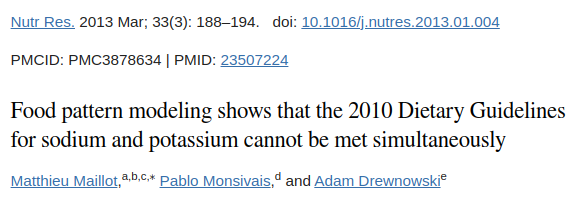
This paper's title is so spectacular that it deserves its own call-out.[27] So what gives? We simultaneously believe that sodium recommendations can go higher, but don't forget about high potassium foods or supplements as well. Athletes need minerals!
At the end of the day, you the consumer should decide what works best for you: do you feel and perform better on a low sodium diet, or a high sodium diet? Have you tested both situations with a blood pressure monitor running on a regular basis for a few days? The name of the supplement game is n=1 experimentation. Try it both ways, measure your blood pressure and see what works for you.
Furthermore, as athletes (which most of Animal's customers are), we need to look at the role of sodium and salt in athletics and muscle contractions - following a low-sodium diet can almost assuredly hamper athletic performance.[28]
Of course, you should discuss this with your doctor, and experiment with a blood pressure monitor, regardless of your health situation.
Coriander in biltong
A special note about coriander, arguably the signature ingredient in the traditional biltong recipe. Usually applied in the form of crushed coriander seed (cilantro seed), this spice exhibits anti-microbial activity so profound that it has actually been proposed as a replacement for preservatives in common commercial use,[29] to which many food-borne pathogens have been steadily becoming resistant.
One study looked at 12 different essential oils and their effect on several strains of the bacterium Campylobacter jejuni, a common cause of food poisoning. It found that coriander had the strongest antimicrobial activity against all strains of bacteria tested. Importantly, the coriander oil inhibited the growth of C. jejuni in a dose-dependent manner.[30]
Animal studies on coriander consistently find that it's capable of reducing blood sugar by activating key enzymes.[31-33] It's also chock full of anti-inflammatory antioxidants[34-36] whose effects may be powerful enough to protect the brain from damage caused by oxidative stress and inflammation.[37,38]
Coriander may also promote healthy digestion and even reduce pain and bloating in patients with irritable bowel syndrome (IBS).[39]
But with regards to what we've discussed in this article, coriander's most interesting property is that it's a powerful diuretic, capable of helping your body excrete extra sodium and lowering blood pressure.[40] In other words, the coriander-heavy biltong recipe may have been designed to balance the higher sodium content.
An amazing (and underrated) spice in an amazing product.
Flavors Available
Whether you like it spicier, sweeter, or standard, the Animal Team has your taste buds covered:
A superior high-protein snack: Animal Beef Biltong
We all love products like Animal Whey, but protein shakes aren't always convenient or truly satisfying. Sometimes we need something to chew on. Plus, for those who don't want dairy - biltong is dairy-free.
And even though Universal Nutrition is primarily a supplement company, there's no reason not to give their customers what they want. Especially since this product has proven that they can do it better than any beef snack manufacturer we've tested -- because Animal Beef Biltong is that good.
Want the ultimate beef stack? Add in some Uni-Liver to make sure you're getting added micronutrients in.
Between Animal Beef Biltong and the new Animal Primal pre-workout, Universal Nutrition is on absolute fire lately - and we're not even referring to the incredible Spicy Chili flavor of Beef Biltong, which all spice-lovers must try. See below for where you can find it:
Universal Animal Beef Biltong – Deals and Price Drop Alerts
Get Price Alerts
No spam, no scams.
Disclosure: PricePlow relies on pricing from stores with which we have a business relationship. We work hard to keep pricing current, but you may find a better offer.
Posts are sponsored in part by the retailers and/or brands listed on this page.
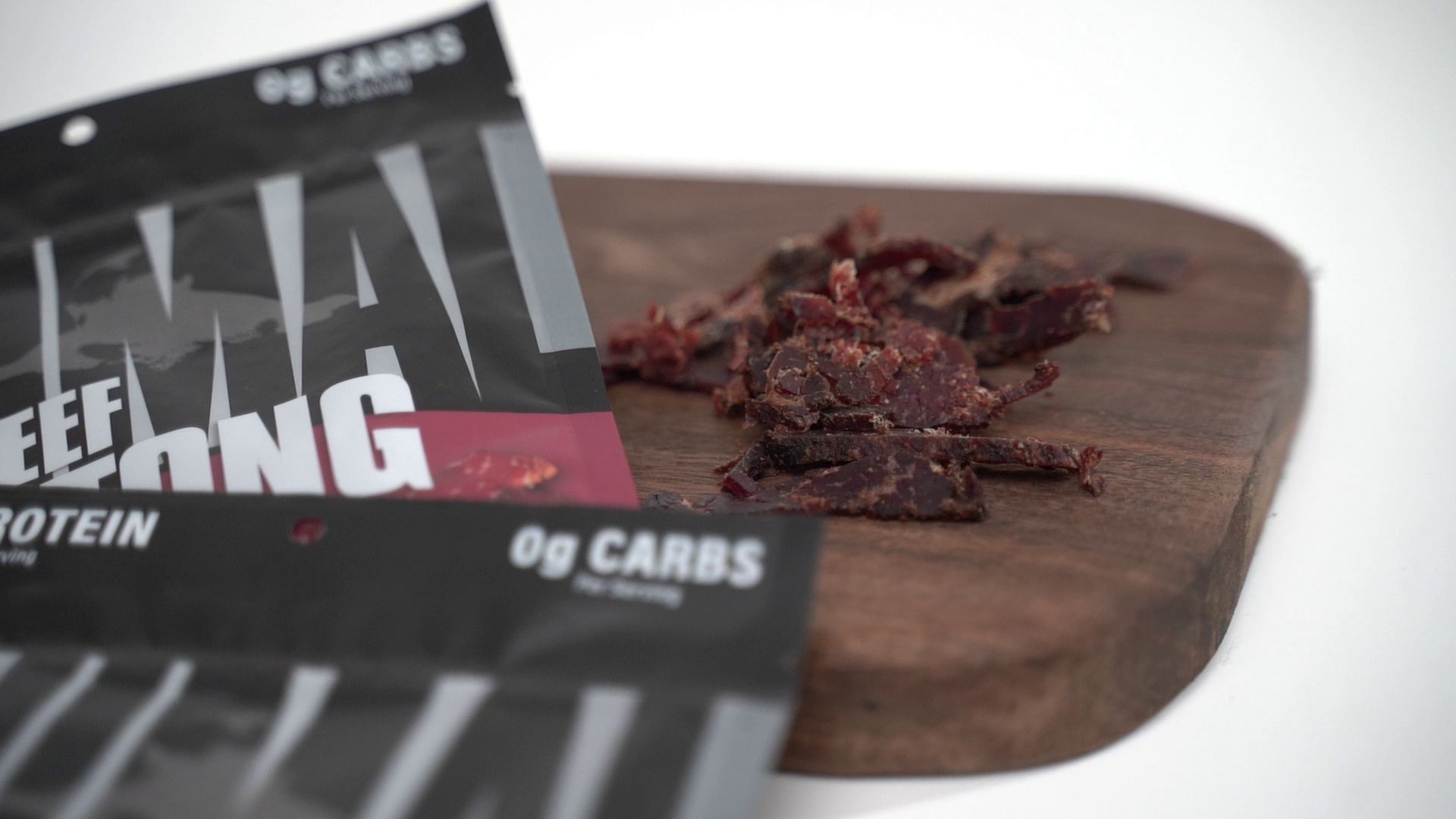
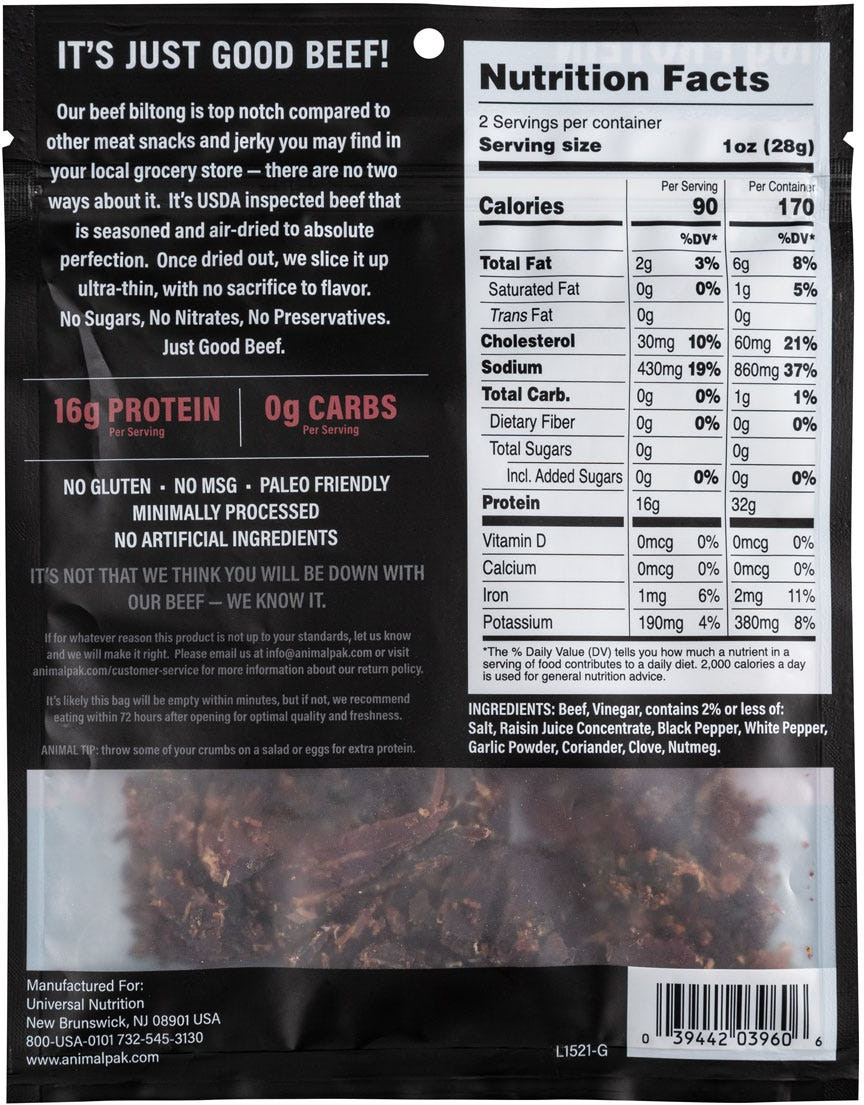
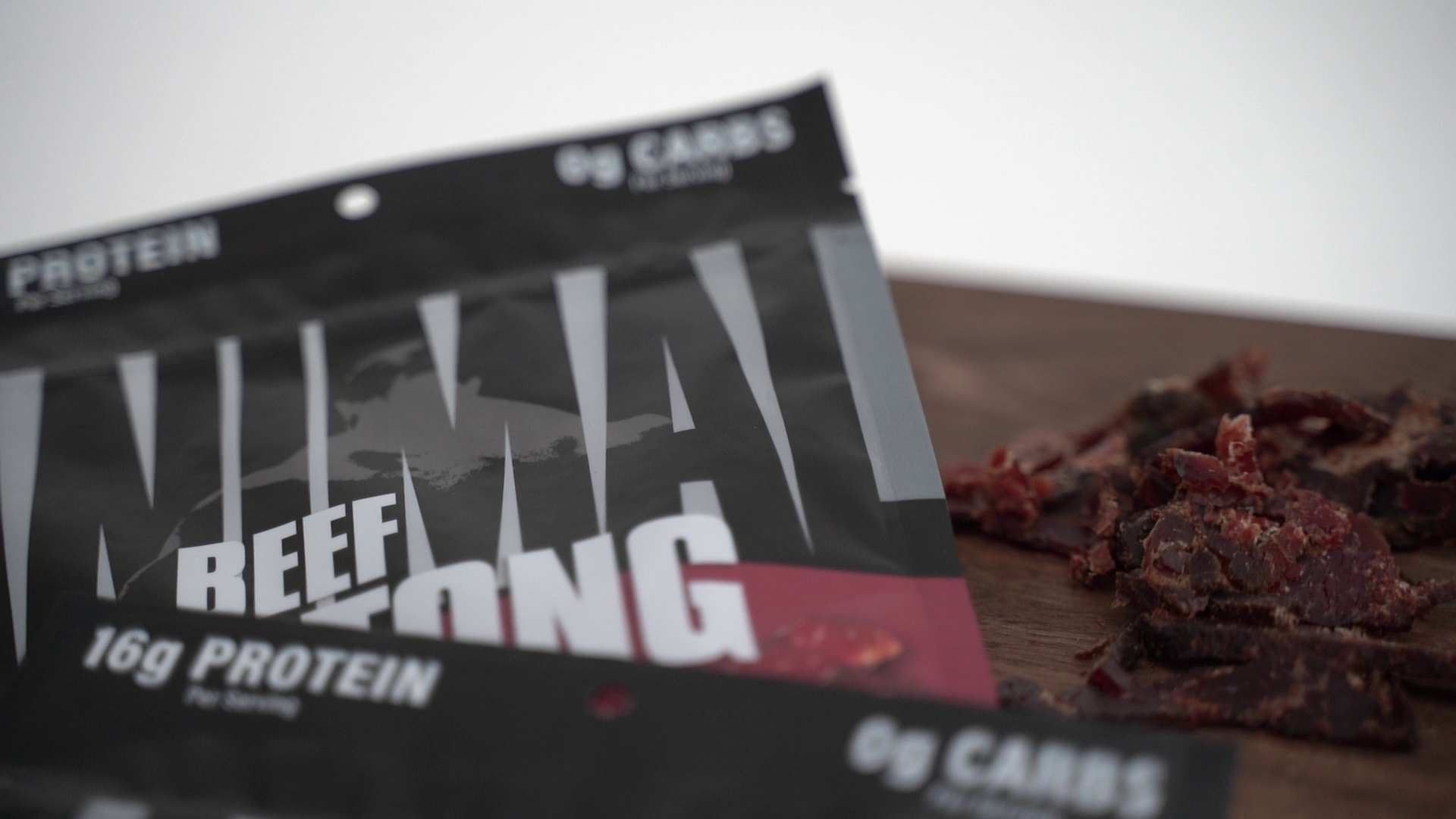
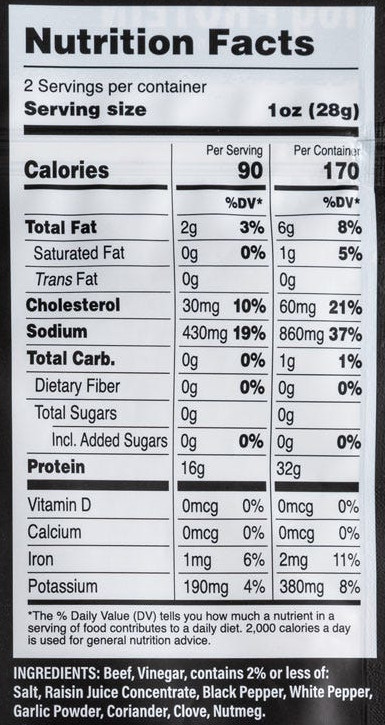
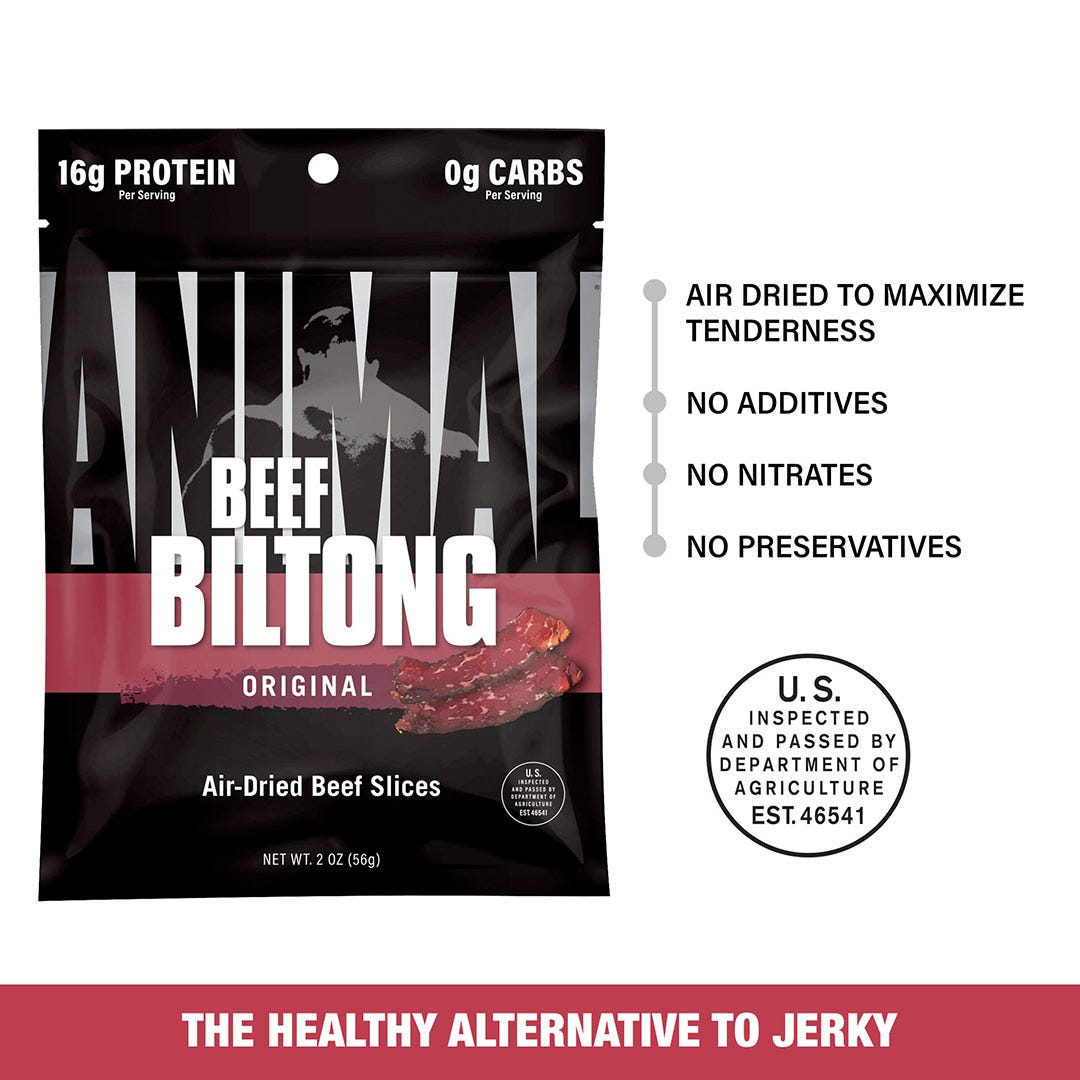
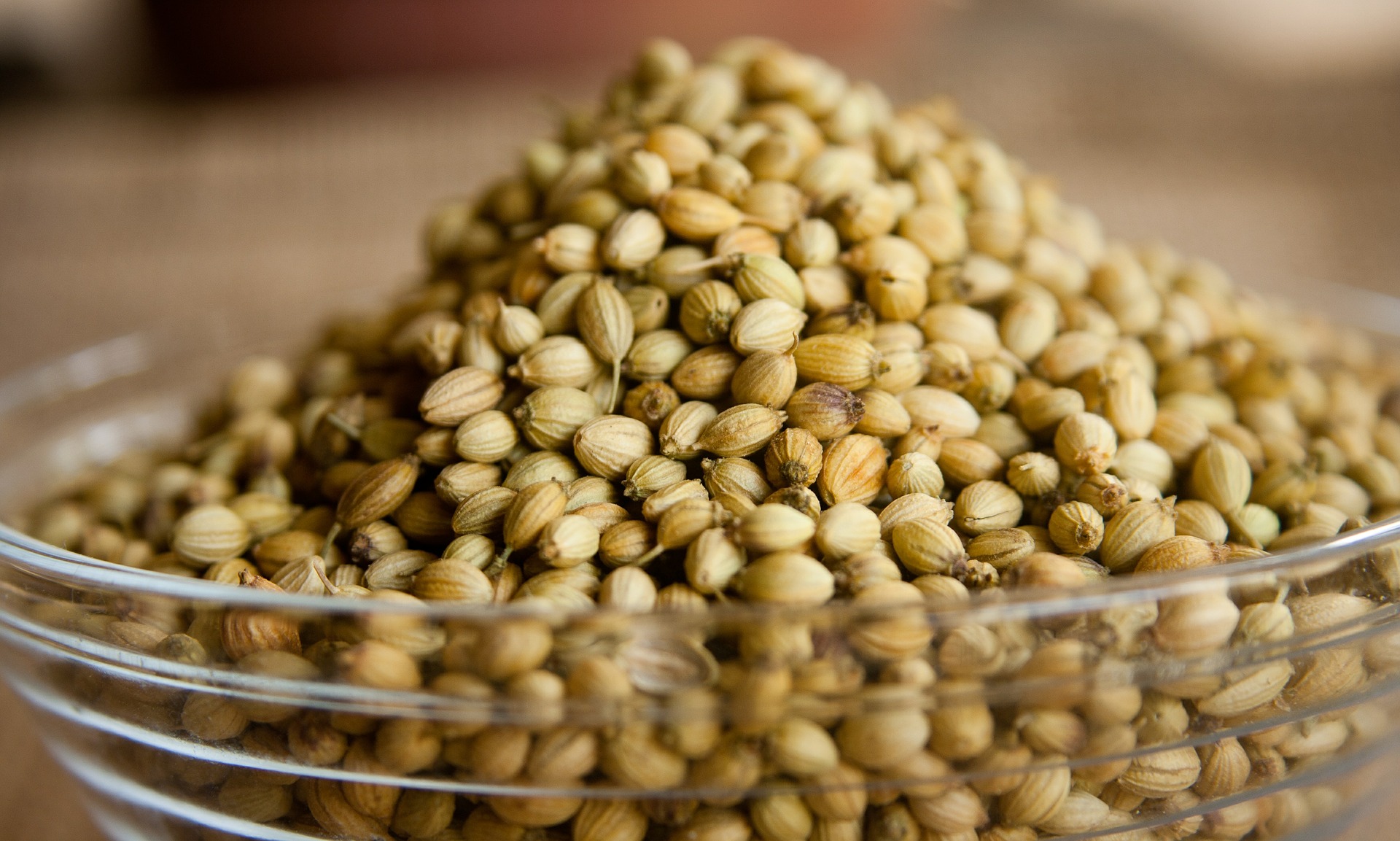
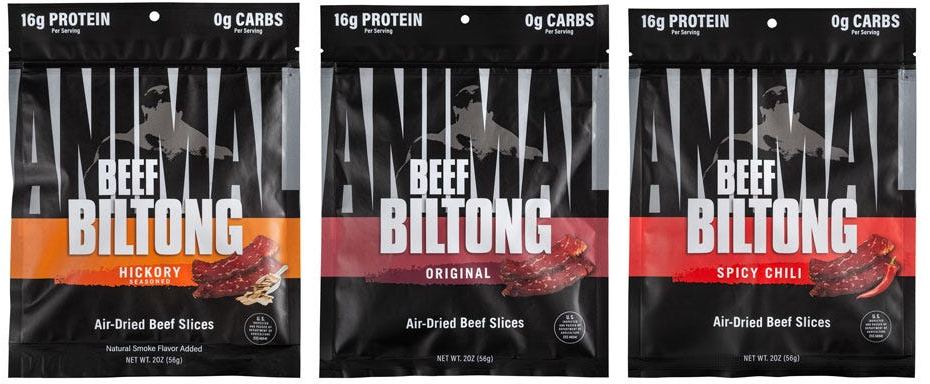
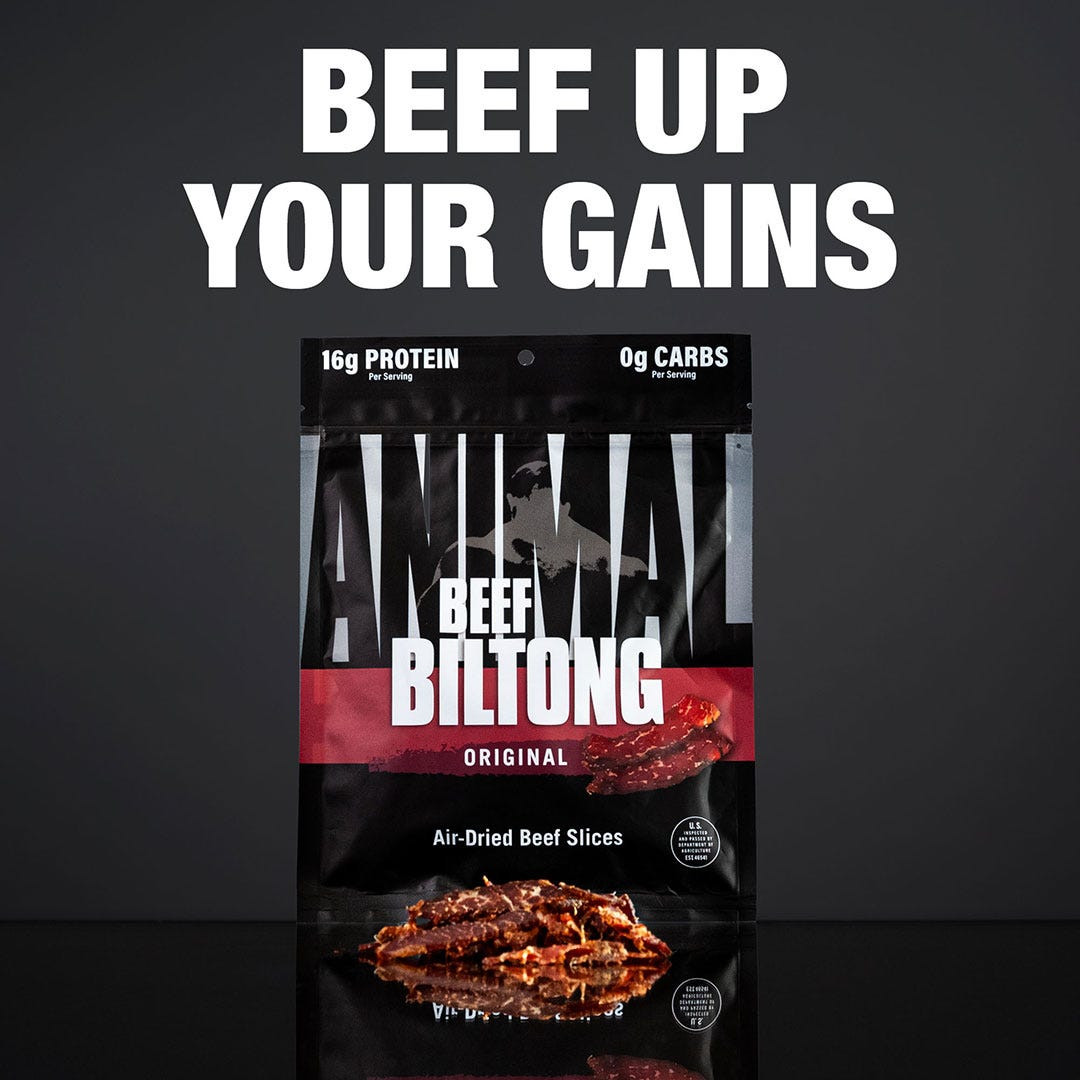


Comments and Discussion (Powered by the PricePlow Forum)